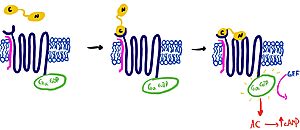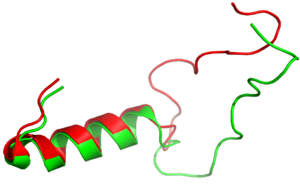Sandbox Ben Whiteside
From Proteopedia
(Difference between revisions)
| Line 5: | Line 5: | ||
==Introduction== | ==Introduction== | ||
| - | When consuming food, the human body is tasked with secreting hormones and chemical messengers that will help regulate homeostasis. After a meal, our body has to maintain homeostasis by reducing our blood glucose and signaling that we have consumed enough nutrients. During feeding, cells in the body will secrete the ligand, amylin. [https://en.wikipedia.org/wiki/Amylin Amylin] is a 37 amino acid glucoregulatory hormone that is produced within beta cells of the pancreas. When there is an influx of nutrients in the gastrointestinal tract, the ligand will bind to the heterodimeric receptor, activating the receptor and triggering the corresponding signaling cascade. The overall effect of this cascade is increased satiety, delayed gastric emptying, and inhibition of glucagon secretion. The amylin receptors are widely distributed throughout the central nervous system. The amylin g-protein coupled receptor <scene name='10/1038828/Entire_protein_scene/4'>(AMYR) </scene>is a heterodimeric protein containing a calcitonin receptor domain, as well as one of three receptor activity modifying proteins (RAMP 1,2, or 3). | + | When consuming food, the human body is tasked with secreting hormones and chemical messengers that will help regulate homeostasis. After a meal, our body has to maintain homeostasis by reducing our blood glucose and signaling that we have consumed enough nutrients. During feeding, cells in the body will secrete the ligand, amylin. [https://en.wikipedia.org/wiki/Amylin Amylin] is a 37 amino acid glucoregulatory hormone that is produced within [https://en.wikipedia.org/wiki/Beta_cell beta cells] of the pancreas. When there is an influx of nutrients in the gastrointestinal tract, the ligand will bind to the heterodimeric receptor, activating the receptor and triggering the corresponding signaling cascade. The overall effect of this cascade is increased satiety, delayed gastric emptying, and inhibition of glucagon secretion. The amylin receptors are widely distributed throughout the central nervous system. The amylin g-protein coupled receptor <scene name='10/1038828/Entire_protein_scene/4'>(AMYR) </scene>is a heterodimeric protein containing a calcitonin receptor domain, as well as one of three receptor activity modifying proteins (RAMP 1,2, or 3). |
<ref name=”Ransey”>PMID:28504306</ref> | <ref name=”Ransey”>PMID:28504306</ref> | ||
<ref name=”Cao”>PMID:35324283</ref> | <ref name=”Cao”>PMID:35324283</ref> | ||
| - | + | [https://en.wikipedia.org/wiki/Beta_cell beta cells] | |
[https://en.wikipedia.org/wiki/Amylin Amylin] | [https://en.wikipedia.org/wiki/Amylin Amylin] | ||
Revision as of 20:30, 24 April 2024
AMYR
| |||||||||||
References
- ↑ Hanson, R. M., Prilusky, J., Renjian, Z., Nakane, T. and Sussman, J. L. (2013), JSmol and the Next-Generation Web-Based Representation of 3D Molecular Structure as Applied to Proteopedia. Isr. J. Chem., 53:207-216. doi:http://dx.doi.org/10.1002/ijch.201300024
- ↑ Herraez A. Biomolecules in the computer: Jmol to the rescue. Biochem Mol Biol Educ. 2006 Jul;34(4):255-61. doi: 10.1002/bmb.2006.494034042644. PMID:21638687 doi:10.1002/bmb.2006.494034042644
- ↑ Ransey E, Paredes E, Dey SK, Das SR, Heroux A, Macbeth MR. Crystal structure of the Entamoeba histolytica RNA lariat debranching enzyme EhDbr1 reveals a catalytic Zn(2+) /Mn(2+) heterobinucleation. FEBS Lett. 2017 Jul;591(13):2003-2010. doi: 10.1002/1873-3468.12677. Epub 2017, Jun 14. PMID:28504306 doi:http://dx.doi.org/10.1002/1873-3468.12677
- ↑ Cao J, Belousoff MJ, Liang YL, Johnson RM, Josephs TM, Fletcher MM, Christopoulos A, Hay DL, Danev R, Wootten D, Sexton PM. A structural basis for amylin receptor phenotype. Science. 2022 Mar 25;375(6587):eabm9609. PMID:35324283 doi:10.1126/science.abm9609
Student Contributors
Andrew Helmerich,Mathias Vander Eide, Ben Whiteside


